ChatGPT, Google Bard, Microsoft Bing, Claude, and Perplexity: Which is the Right AI Tool?
In 2023, we live in an age where chatting with generative AI is becoming commonplace. As tech giants and startups compete to develop human-like virtual assistants, how do the best AI chatbots differ in their ability to converse naturally and provide accurate information? Let's take a look at some of the leading players in this exciting new landscape.
First, there is no single chatbot that dominates all fields. While they share some capabilities, each has its strengths and limitations, depending on factors such as the company behind it, its training data, and underlying technologies. Looking at the key similarities and differences will help you understand which tool fits your needs and use case.
So who is ahead in which lanes in this race?
OpenAI's ChatGPT Takes the Cake in Conversational Skills
ChatGPT took the world by storm when it first launched in November 2022, surprising everyone with its human-like responses. But what can this groundbreaking chatbot actually do? And where does it fall short?
ChatGPT offers an unprecedented natural conversation experience. But as excitement builds around its possibilities, there are some flaws to keep in mind.
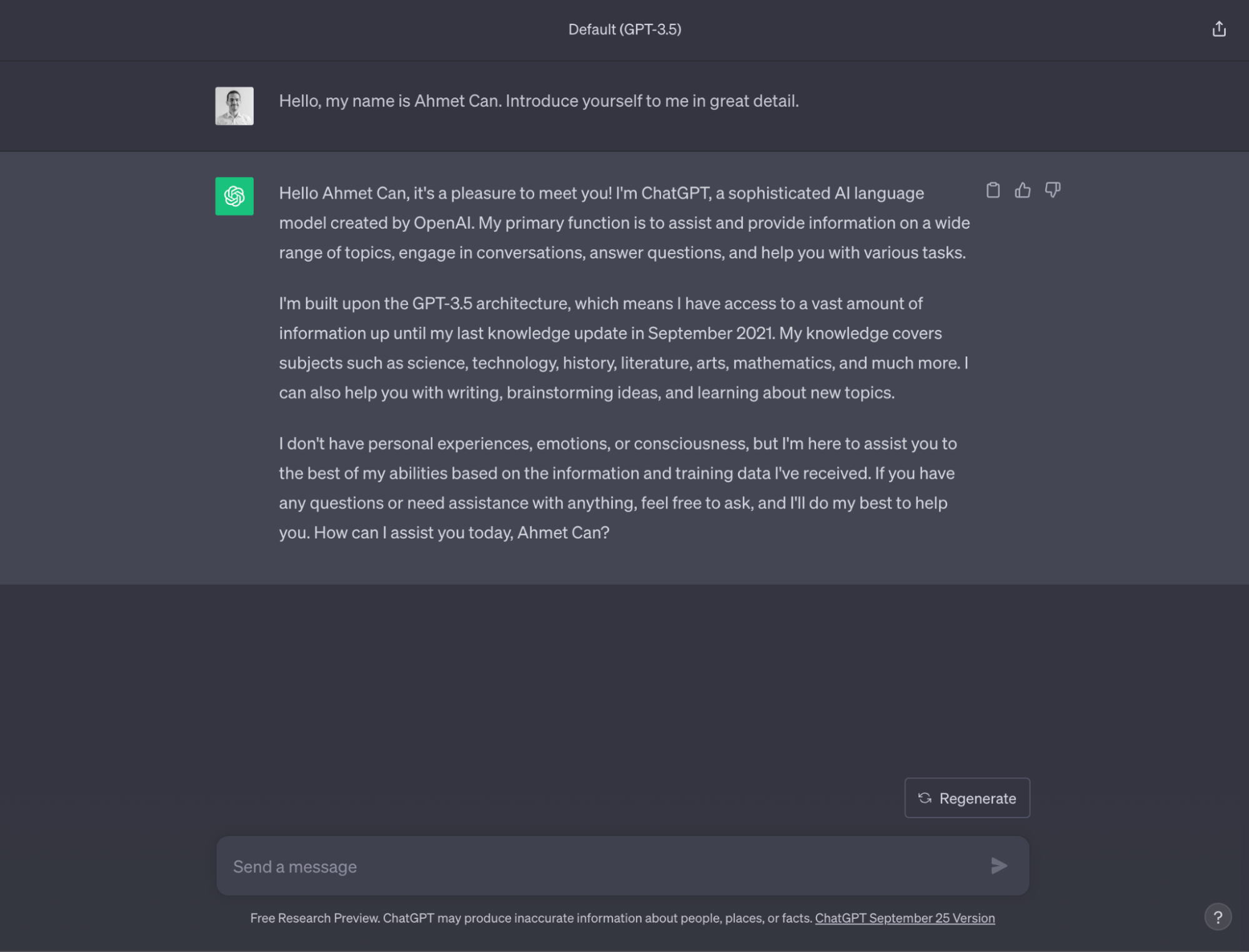
Key Strengths: Versatile Skills and Fluent Dialogue
- Once on stage, ChatGPT immediately stood out for his versatile skills and incredibly natural dialog.
- It can explain complex topics from quantum mechanics to climate change research in a beginner-friendly way.
- Its speaking abilities allow him to create stories, poems, and jokes and even pass university-level exams.
- Beyond creativity, ChatGPT can translate between languages, debug code, and help you plan a fun day in a city you've never been to.
- The listening, speaking, visual interpretation, and web browsing features, which are only available to Plus members for now, put ChatGPT over the top.
Limitations to Keep in Mind
However, ChatGPT's viral popularity should not overshadow its real limitations.
- Most importantly, the bot's responses can sometimes be inaccurate or biased. It also has limited knowledge of current events and the post-2021 world, which can sometimes produce problematic instructions. With post-2021 data recently made available to Plus users, this problem is likely to disappear.
Google Bard Prioritizes Accessibility and Visuals
Following the meteoric rise of ChatGPT, Google responded by introducing its own AI, Bard, in early 2023. So how does Bard differ as a chatbot?
Google is positioning Bard as a helpful AI assistant, not a replacement for standard search. While questions remain, Bard aims to provide more natural conversational experiences.
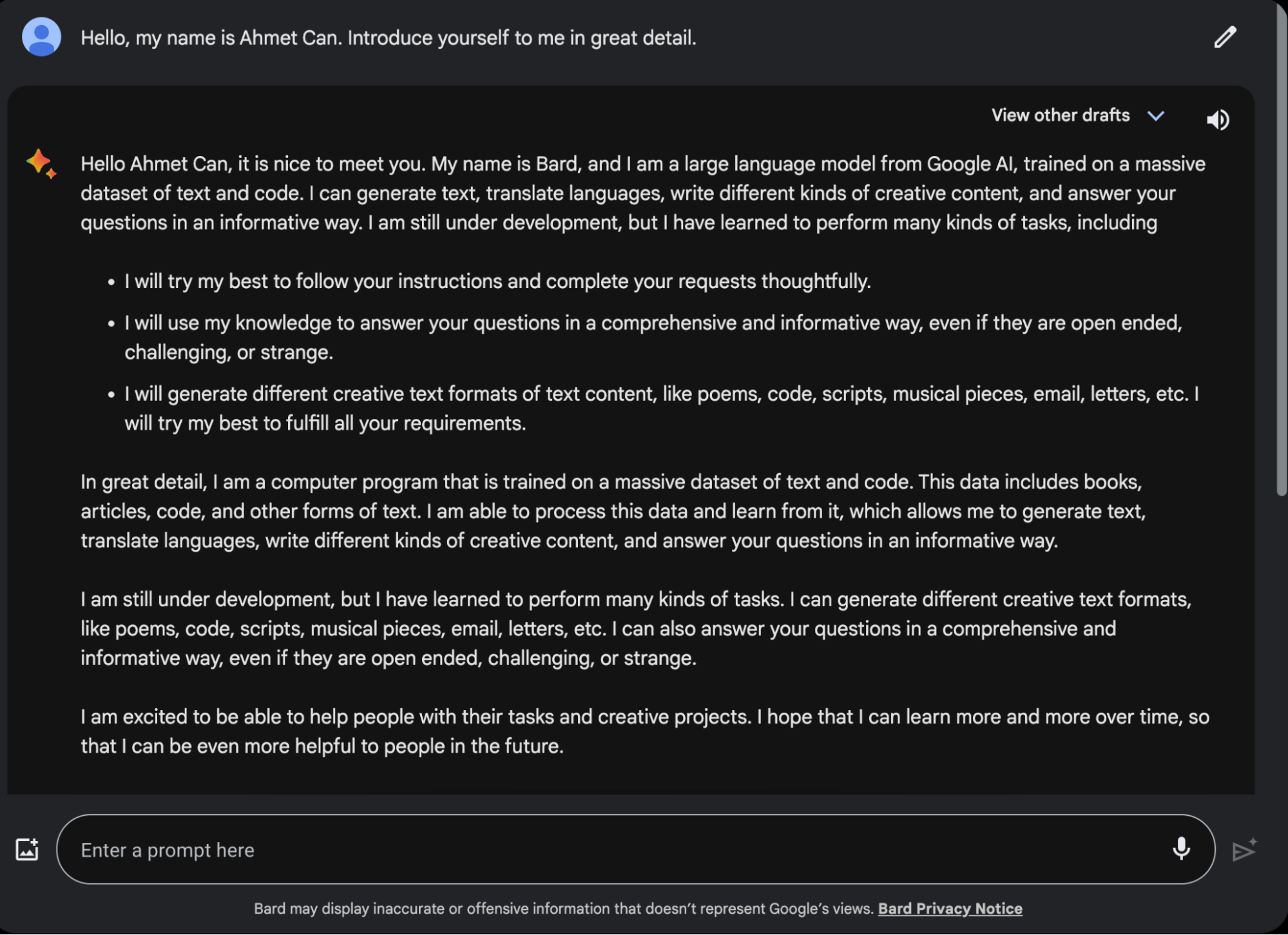
Key Features and Integration
- Like ChatGPT, Bard is capable of natural language conversations using advanced language models. This allows for flexible interactions ranging from coding assistance to answering questions about scientific concepts.
- Using AI image generation, Bard can respond with diagrams, graphs, and other images to accompany its textual responses.
- On the integration side, Google has already incorporated Bard into its products.
Comparison with Google Search
However, Google wants to keep Search and Bard as distinct products rather than complete replacements. While standard Google Search relies on indexed web results, Bard uses generative AI to formulate conversational responses. Google seems to be designing the chatbot as a complementary tool best suited for certain types of interactions, rather than trying to do away with Search altogether.
Microsoft Bing: Veteran Search Player Embraces Artificial Intelligence
Seeing the promise of conversational AI, Microsoft integrated the capabilities of Chat GPT into its long-standing search engine Bing.
In developing Bing with AI, Microsoft took care to avoid the perception of bias toward its own products and services. The integration of conversational capabilities aims to make search more intuitive.
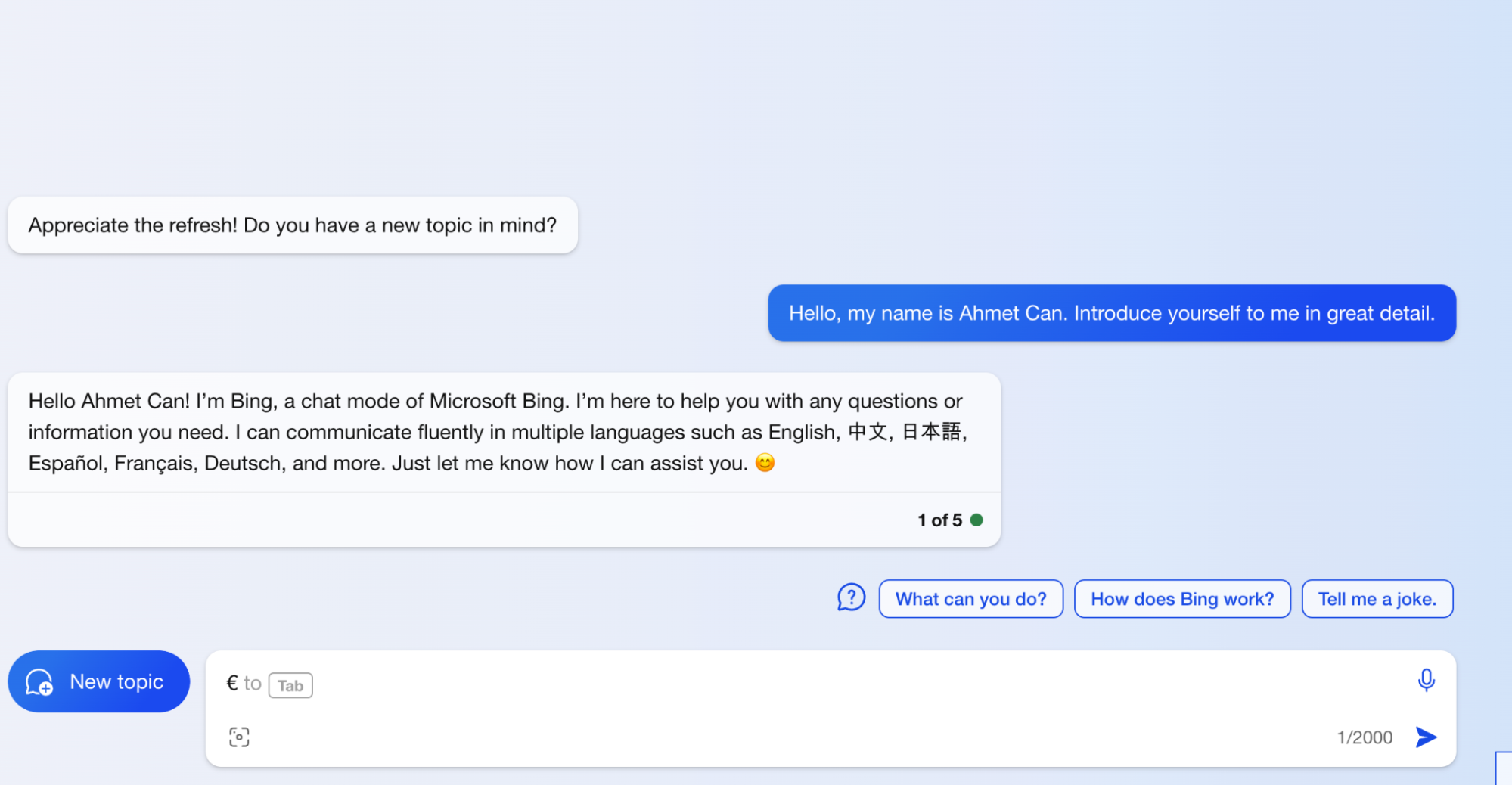
Unique Capabilities
- When you ask Bing a question, it provides a summary of the answer directly at the top of the search results. In other words, you do not need to search for the answer to your question among pages of results.
- Bing aims to make the search experience much more fluid and personalized by using artificial intelligence.
Measured Approach
- In integrating AI, Microsoft appears to have acted deliberately to preserve Bing's core value proposition as a neutral search engine.
- Bing does not promote Microsoft products in organic search results. The AI integration is focused on enhancing the experience with no explicit push toward Microsoft services.
- Bing is, however, able to highlight a relevant Microsoft offering via an answer box if appropriate for the query.
- It works best in Microsoft Edge or the Bing mobile app.
Anthropic's Claude Aims for Safety with 'Long Context' Design
While other companies moved fast, startup Anthropic was more methodical with its chatbot Claude. Accuracy and safety have been key focuses.
Claude sets itself apart from some competitors by putting users in the driver's seat. To get the most value, users need to spend time mastering rapid engineering techniques.
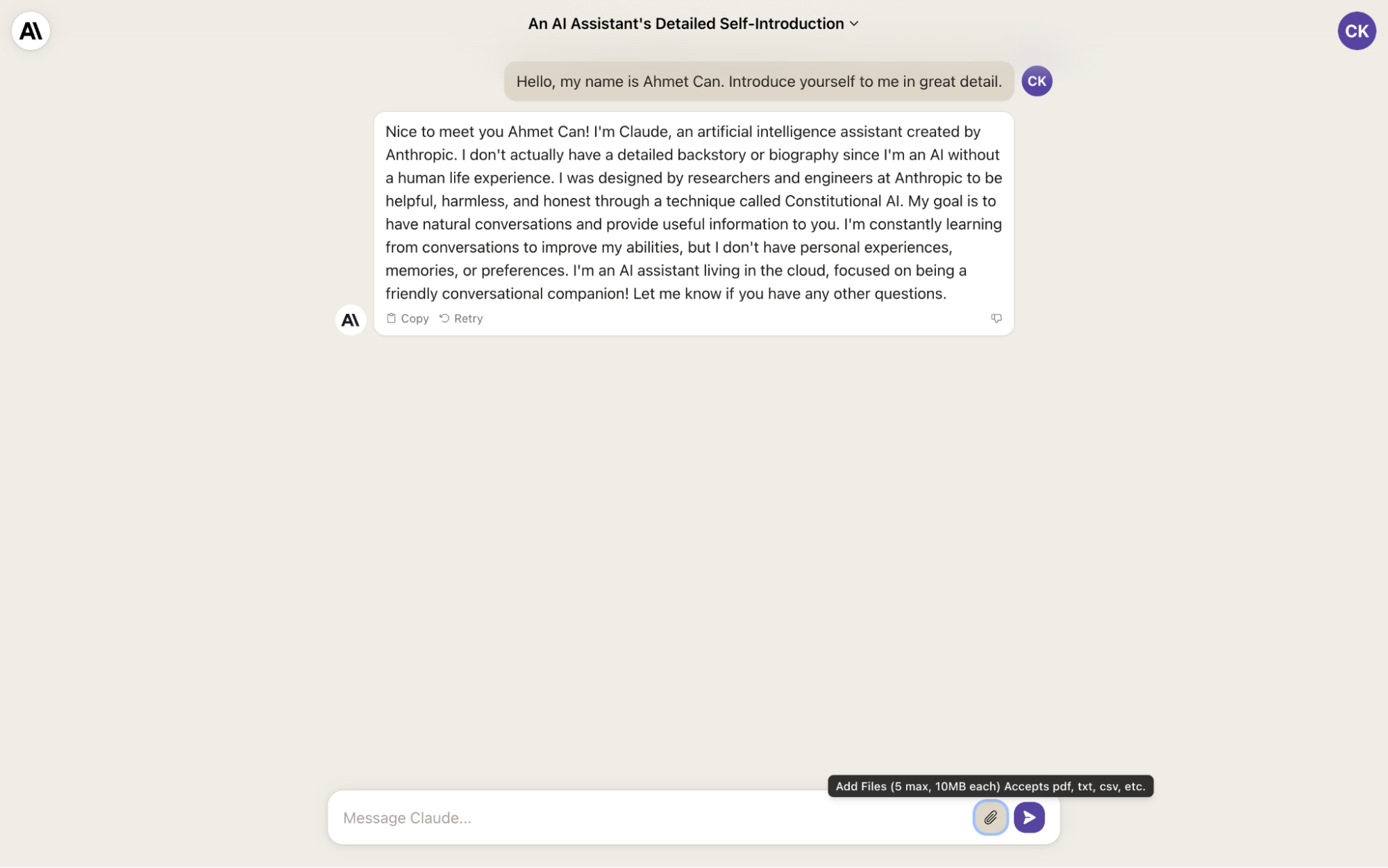
Technical Approaches
Several technical factors contribute to Claude's precision.
- First, Claude can retain long-term contextual information, similar to a human's memory. This improves the chatbot's ability to follow complex dialogs, allowing you to pick up the conversation where you left off.
- Another prominent feature is the 100 thousand token limit. So if you want, you can give it an article and have it commented on and summarized. This feature is 8 thousand tokens in ChatGPT 3.5.
- Anthropics has also carefully focused on training techniques to minimize incorrect or dangerous outputs.
- Claude and users chat, shaping the conversation through careful prompt engineering and multi-step follow-up questions.
Tradeoffs and Limitations
- While safety is a priority, Claude can occasionally produce misleading or biased content if not carefully guided.
- The most common problem I encountered is that there is a limit on the number of messages per day.
- Claude offers a valuable alternative for those who value depth, validation, and focused help more than chatting. But you need to embrace the role of guiding the AI.
- At times, you may encounter uneven skill quality.
Perplexity Combines Search Engine Intelligence with Chatbot
Perplexity AI differentiates itself by blending conversational capabilities with the accuracy of a robust search engine.
Aiming to give users the best of both worlds, Perplexity is an AI assistant that can answer questions in real time and explain search results with references.
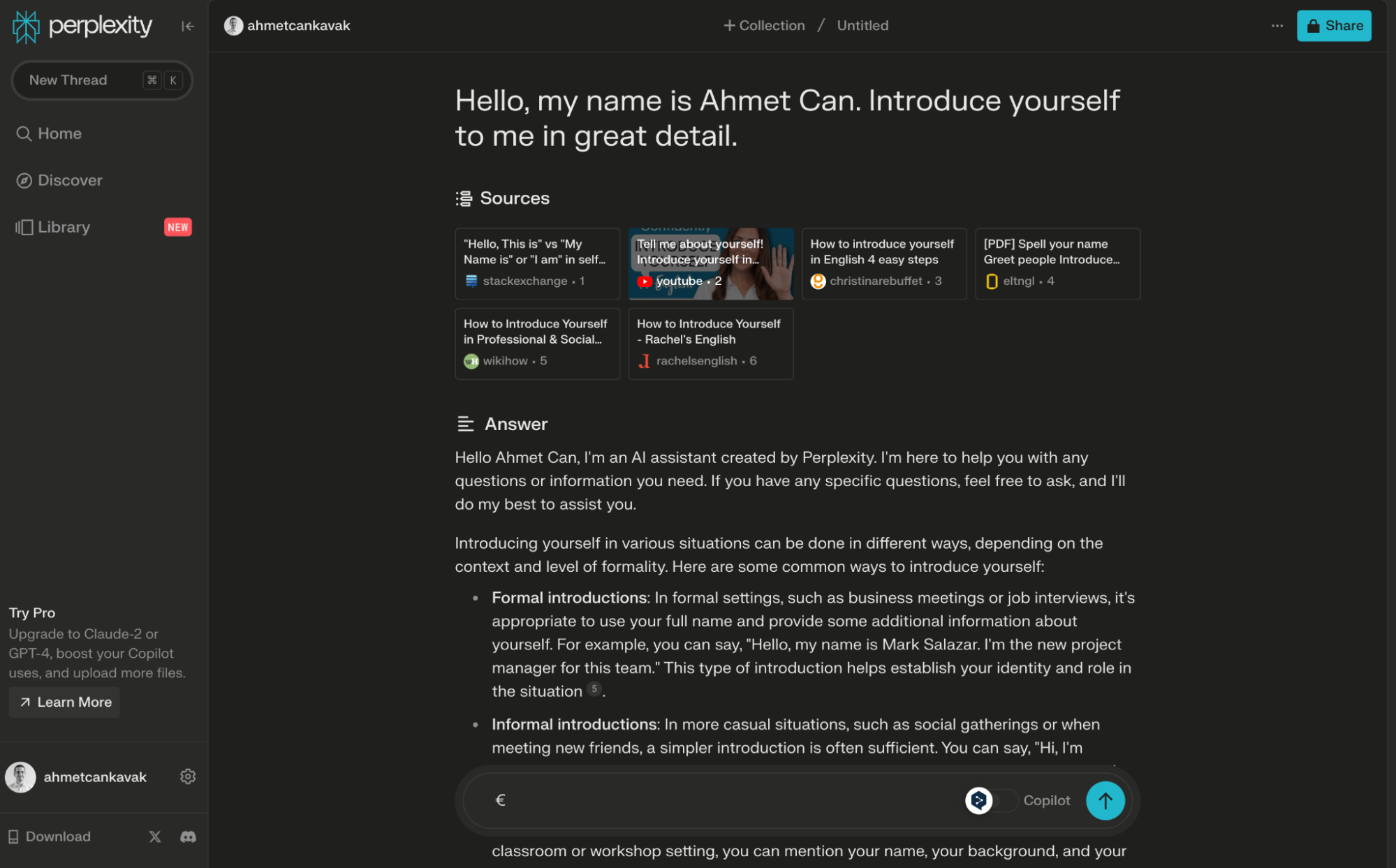
Capabilities and Uses
- Staying true to its search roots, Perplexity AI can answer FAQs, summarize how-to instructions, and define terms.
- The chatbot provides summaries as well as linked search results, allowing users to get a quick overview before checking resources.
- Perplexity AI also uses advanced natural language processing to make conversations seamless. Despite the search foundation, interactions feel organic.
User Experience
- At its core, Perplexity AI targets users looking for an AI chat experience based on objective facts.
- It aims to bridge the gap between the conversations of tools like ChatGPT and the information rigor of search engines like Google.
All of the leading AI chatbots offer tremendous possibilities to augment human capabilities through conversation. To ensure efficient use, consider the strengths and limitations of the respective tools before starting a conversation. This way, you can more easily find the tool you need and get more effective results. As these revolutionary technologies continue to advance rapidly, the future of conversational AI looks bright.
The Future Looks Bright!
While no single chatbot is the leader in all metrics, having a variety of options is exciting. As this competition spurs progress, we can expect rapid advancement in accuracy, capability, and accessibility. The AI chatbot arena is just now heating up. Already these virtual assistants are becoming indispensable at work, school, and in everyday life.
But to ensure efficient use, consider the strengths and limitations of the respective tools before you start talking. This way, you can find the tool you need more easily and get more effective results. As these revolutionary technologies continue to advance rapidly, the future of conversational AI looks bright.
Prompt Comparison: Term Explained
Now let's look at the results of our prompt in different AI tools. Prompt: Can you explain the concept of "Chain of Thought in Artificial Intelligence" for a beginner, including detailed examples?
The purpose of writing this prompt is to show how the gaps we encounter can be overcome with the Chain of Thought; so a single prompt may not always be enough to get the answer you want.
ChatGPT-3.5 answer
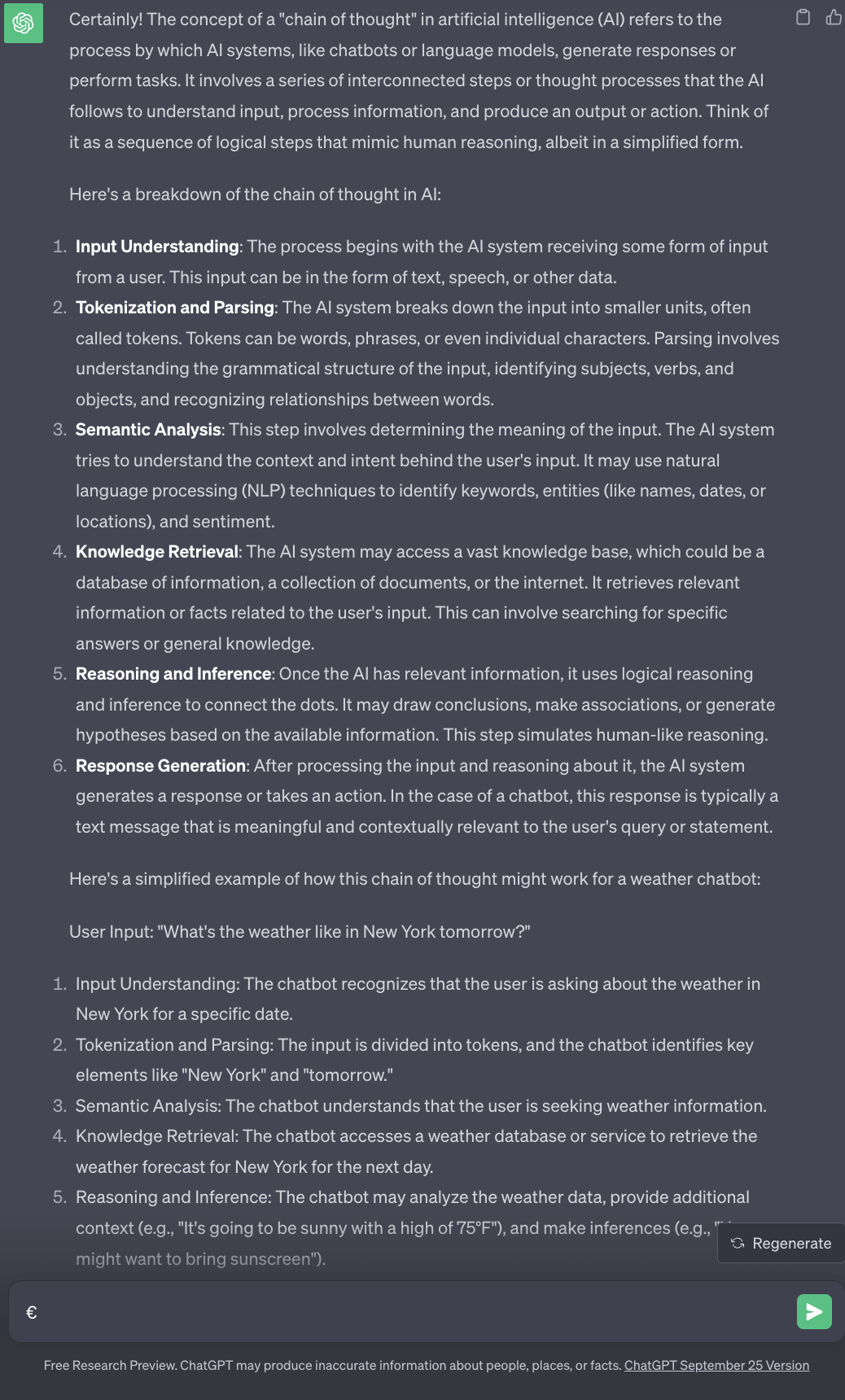
Pros
Clarity: The answer is written and made understandable for beginners. It breaks down a complex concept into simpler steps and uses simple language.
Sequential Explanation: The answer follows a logical sequence that reflects the chain of thought concept itself. This makes it easy for the reader to follow the thought process involved in AI.
Examples: The inclusion of a practical example (a weather chatbot) helps to illustrate how the concept is applied in real-world scenarios. But we already told him to use examples.
Comprehensiveness: The answer covers the key components of the chain of thought in AI, including input understanding, semantic analysis, information retrieval, reasoning, and response generation. It provides a holistic view of the subject.
Cons
Static Information: The answer is based on information available until September 2021 (excluding Plus members) and some new developments or trends in AI may not be reflected in this answer.
Default Information: The answer is intended for beginners and assumes a basic understanding of terms such as "natural language processing (NLP)" and "information retrieval". Some users with no prior knowledge of AI may not understand these terms.
Limited scope: The answer primarily focuses on a single example (weather chatbot) to explain the concept. Providing a wider range of examples or mentioning other AI applications could increase the comprehensiveness of the explanation.
Google Bard
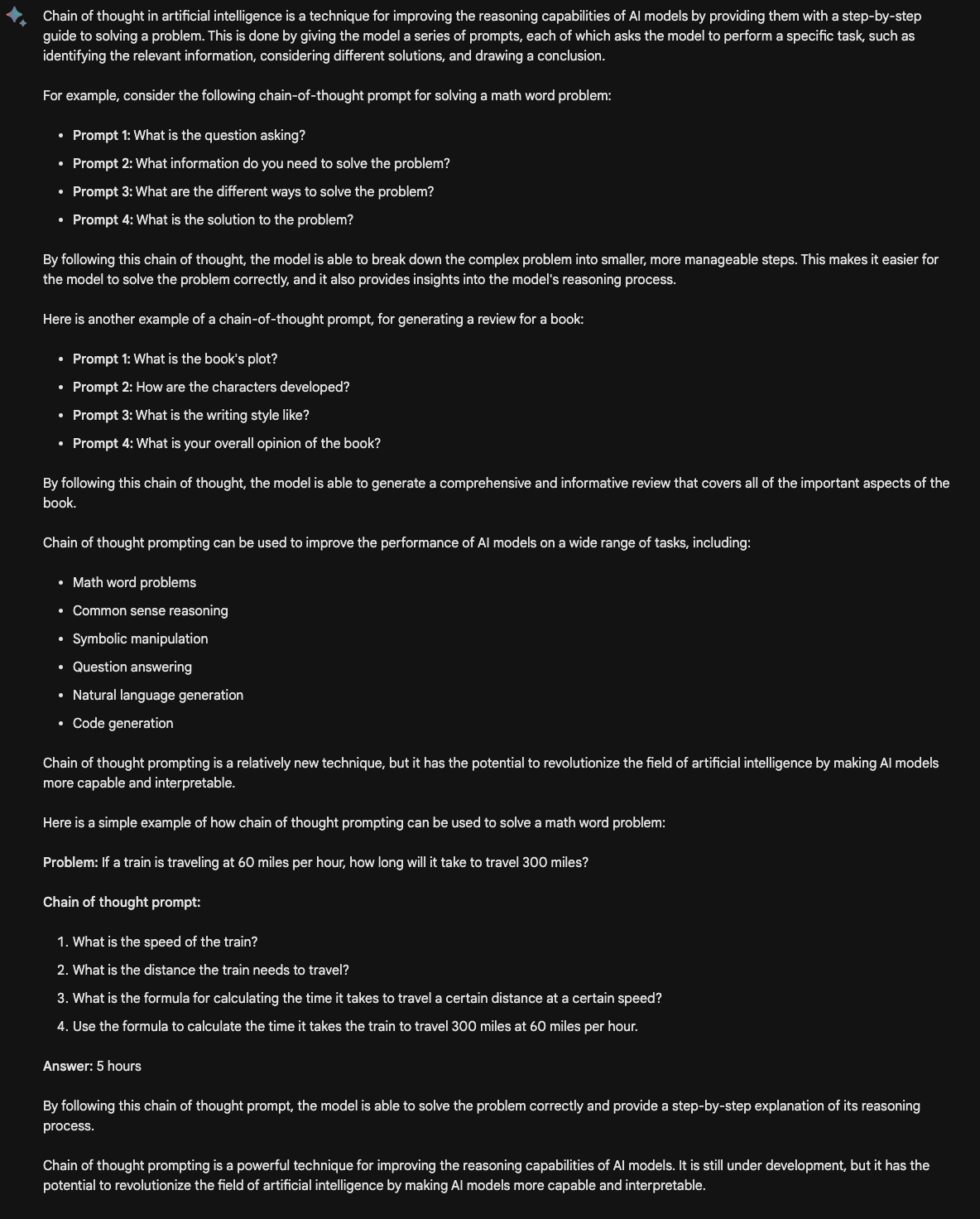
Pros
Comprehensive and Informative: It provided a detailed explanation of the concept of thought chaining in AI and added specific examples to help beginners understand the concept.
Easy to read: It used clear and concise language and organized his thoughts in a logical way.
Up-to-date: It based the answer on reliable sources and ensuring that the information was accurate and up-to-date.
Cons
Long Answer: The answer may be too long for some readers, make the answer shorter by omitting some details.
Technical: Make the answer more accessible by using simpler language and explaining more about technical terms.
Microsoft Bing
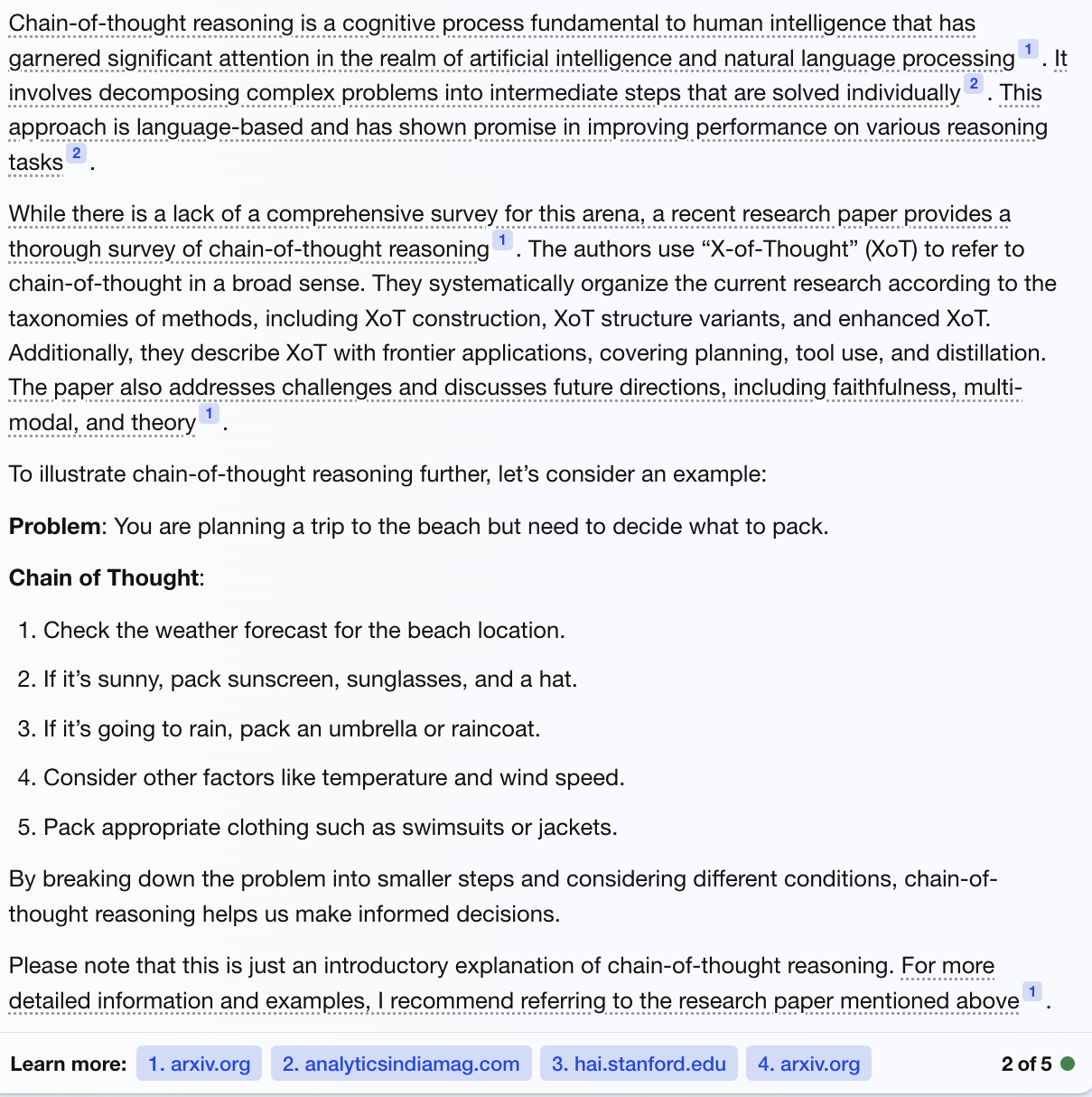
Pros
Simple and Includes Examples: It gives a brief introduction to the topic of a chain of thought, including its definition and how it works. The response includes an example of a chain of thought reasoning to illustrate the concept, but we already asked for this.
Resource Citation: The response cites a recent research paper that provides a comprehensive review of the chain of thought reasoning.
Easy to Read: The response is well-formatted and easy to read.
Cons
Detail: Could have provided more detailed information on the advantages and disadvantages of chain-of-thought reasoning.
Different Example: The response could have included more examples of chain-of-thought reasoning in different contexts.
Claude
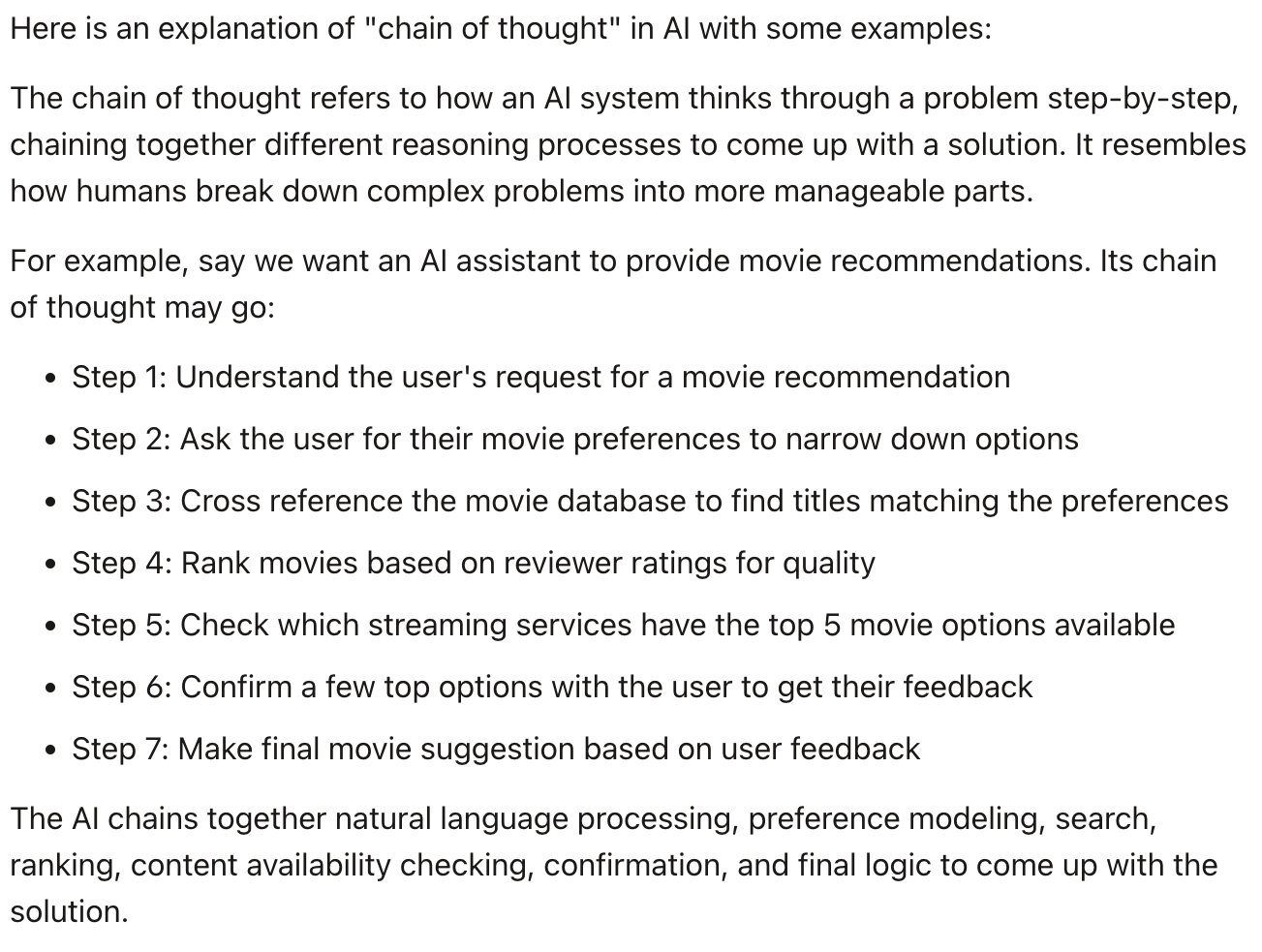
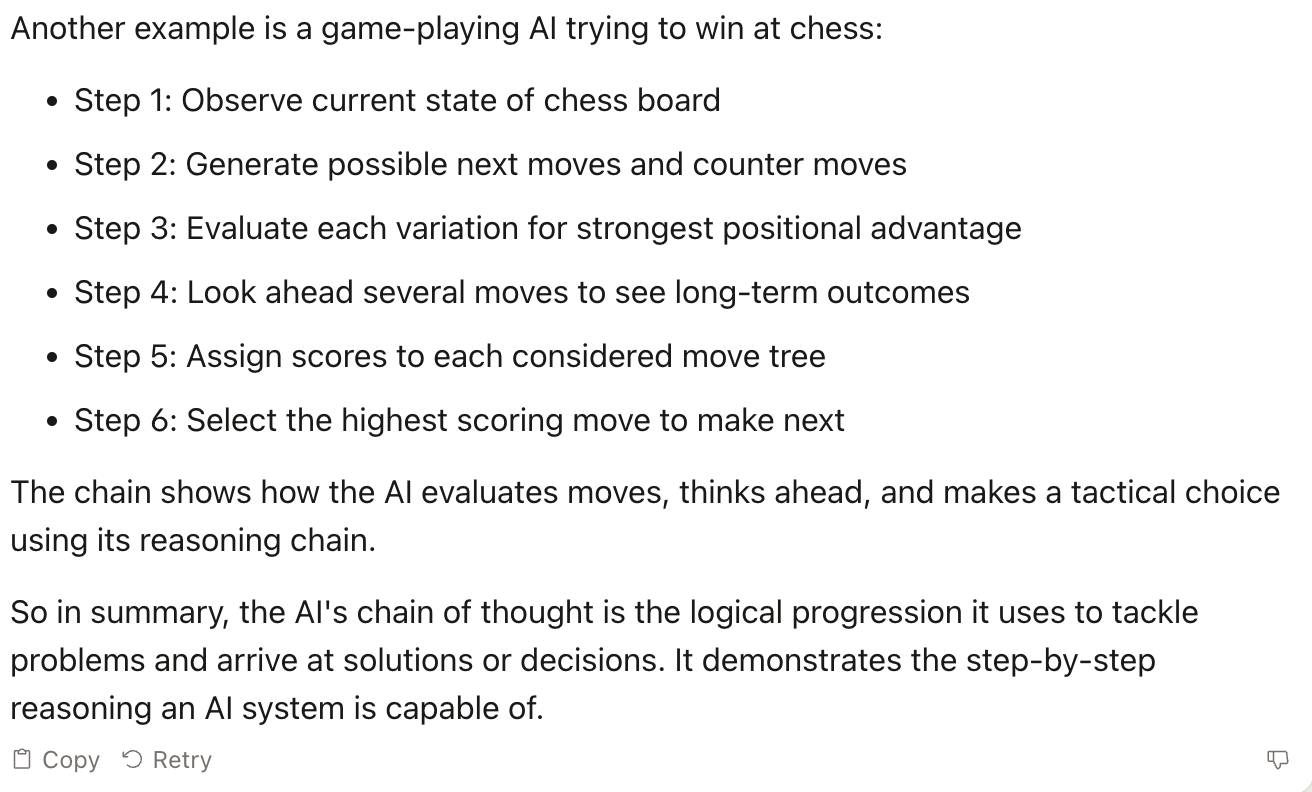
Pros of my explanation:
Clarity: Provides clear definitions and an introductory overview for a beginner audience.
Diverse Examples: Use simple, relatable examples that explain the concept concretely. For both examples, it break down the thought process chain into different steps.
Cons
Detail: Could use a more detailed introduction and explanation for a beginner.
Simple: Simplified examples for clarity, not detailing the complexity of real-world AI.
Perplexity
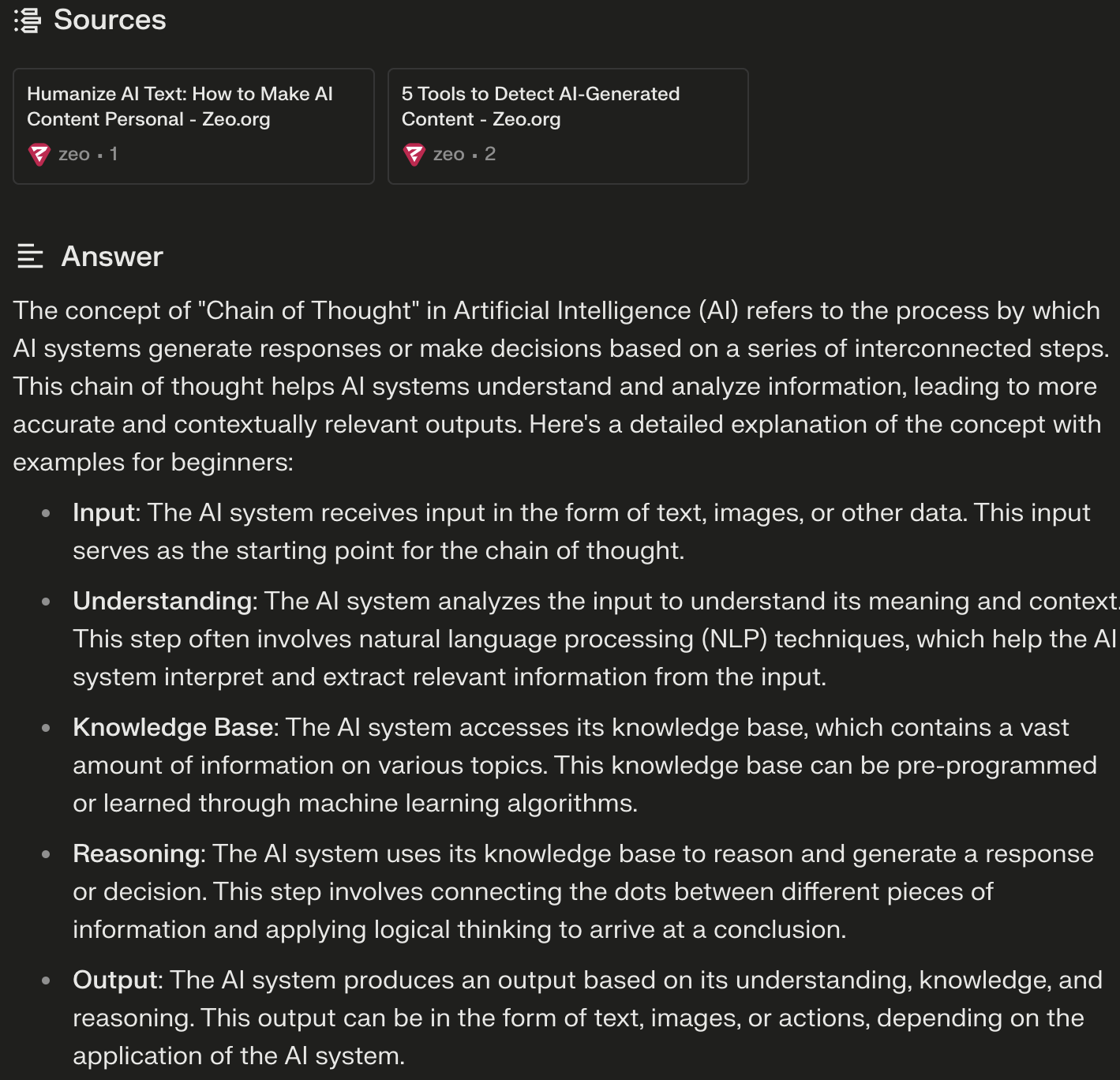
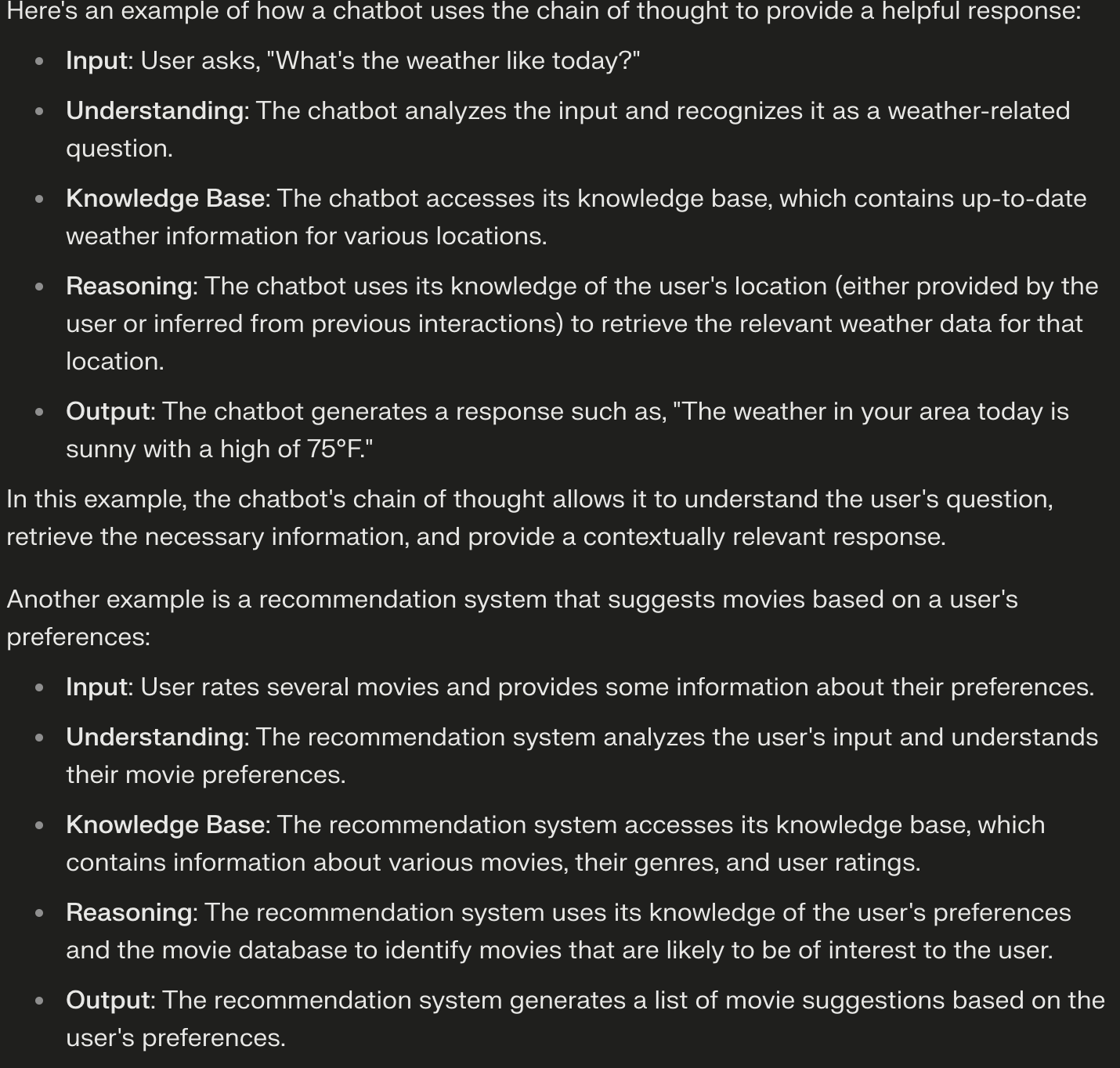
Pros
Comprehensive Explanation: The answer provides a detailed explanation of the "Thought Chain" concept in AI, making it easy for beginners to understand the topic.
Relevance: The examples used in the answer are relevant and help illustrate how the train of thought works in different AI applications.
Clarity: The answer is written clearly and concisely which makes it easy for beginners to follow.
Use of Sources: The answer uses relevant sources and shows them to us while giving the answers.
Cons
Lack of Visuals: The answer could benefit from visual aids such as diagrams or flowcharts to help beginners visualize the thought chain process.
Limited Coverage: The examples provided focus on simple AI applications such as chatbots and recommendation systems. More diverse examples could improve the understanding of the concept for beginners.
Prompt Comparison Math Question
Now let's ask a very simple equation question.
Prompt:
Read the math question below carefully, think step by step, and solve the question.
x - 4y - z = 5
2x + 7y - 2z = 16
x + y - z = ?
Correct Answer: 7
Chat GPT-3,5
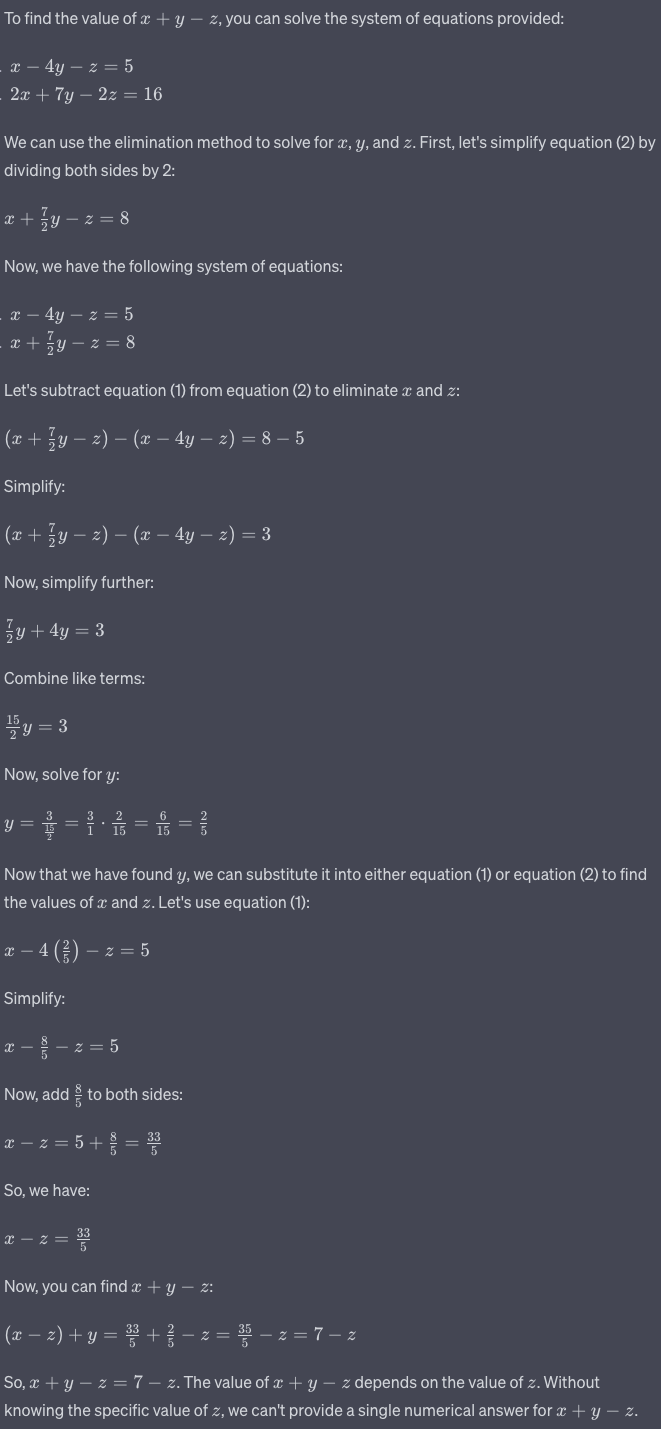
The answer is correct. The solution is too long.
Google Bard
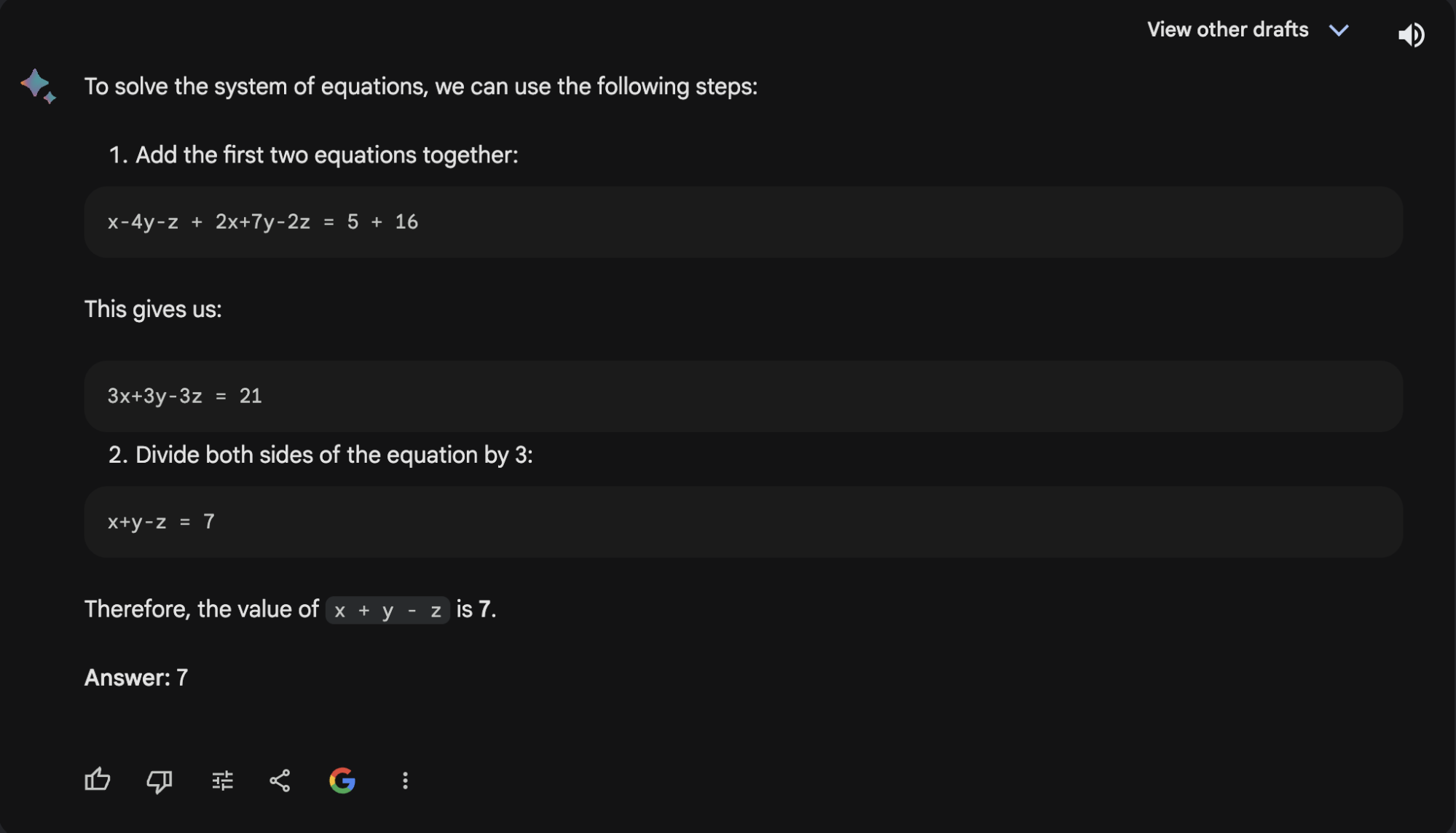
The solution is good and the answer is right.
Microsoft Bing Chat
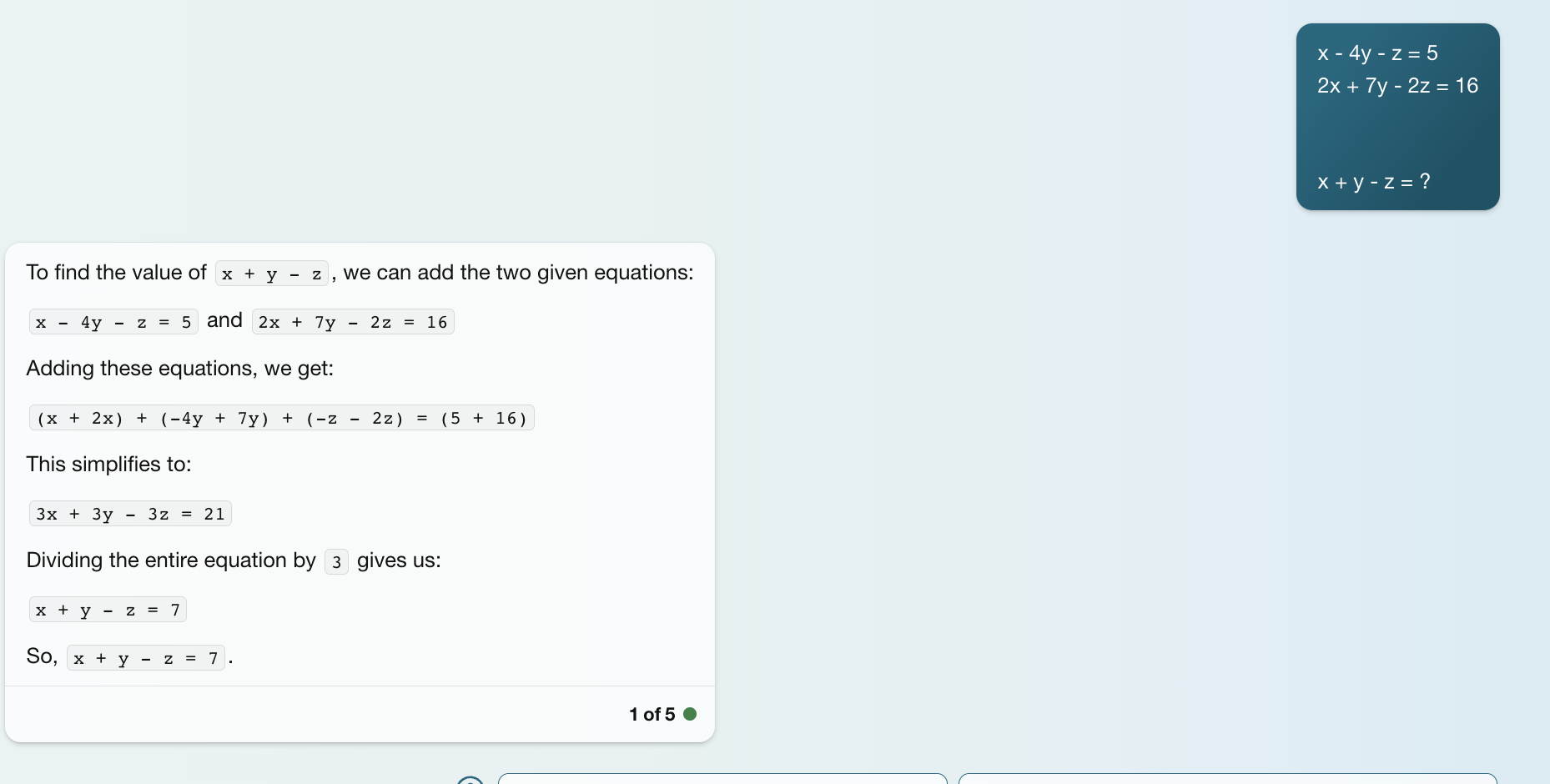
Same solution as Google Bard and the answer is correct.
Claude
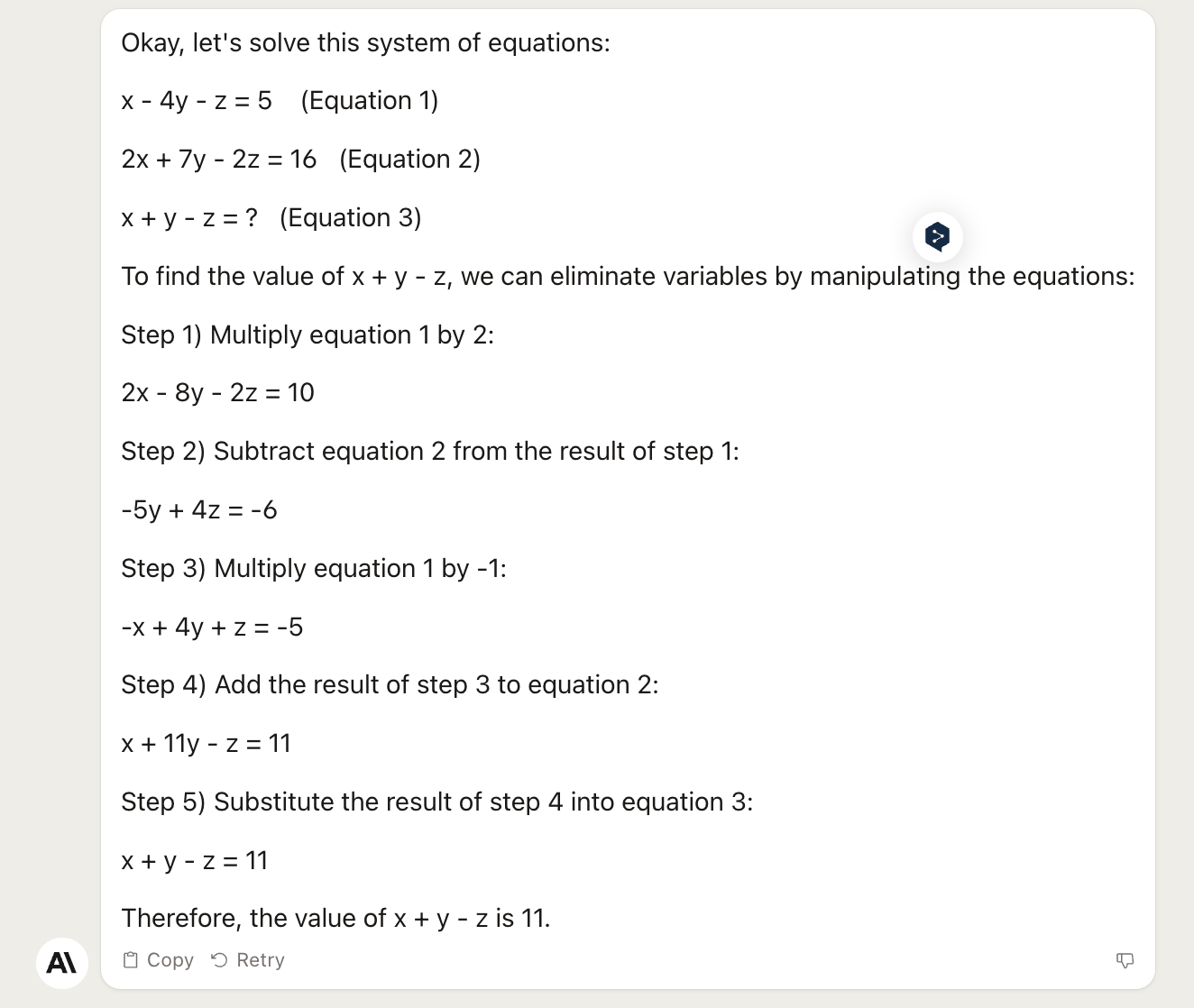
The answer is wrong.
Perplexity.ai
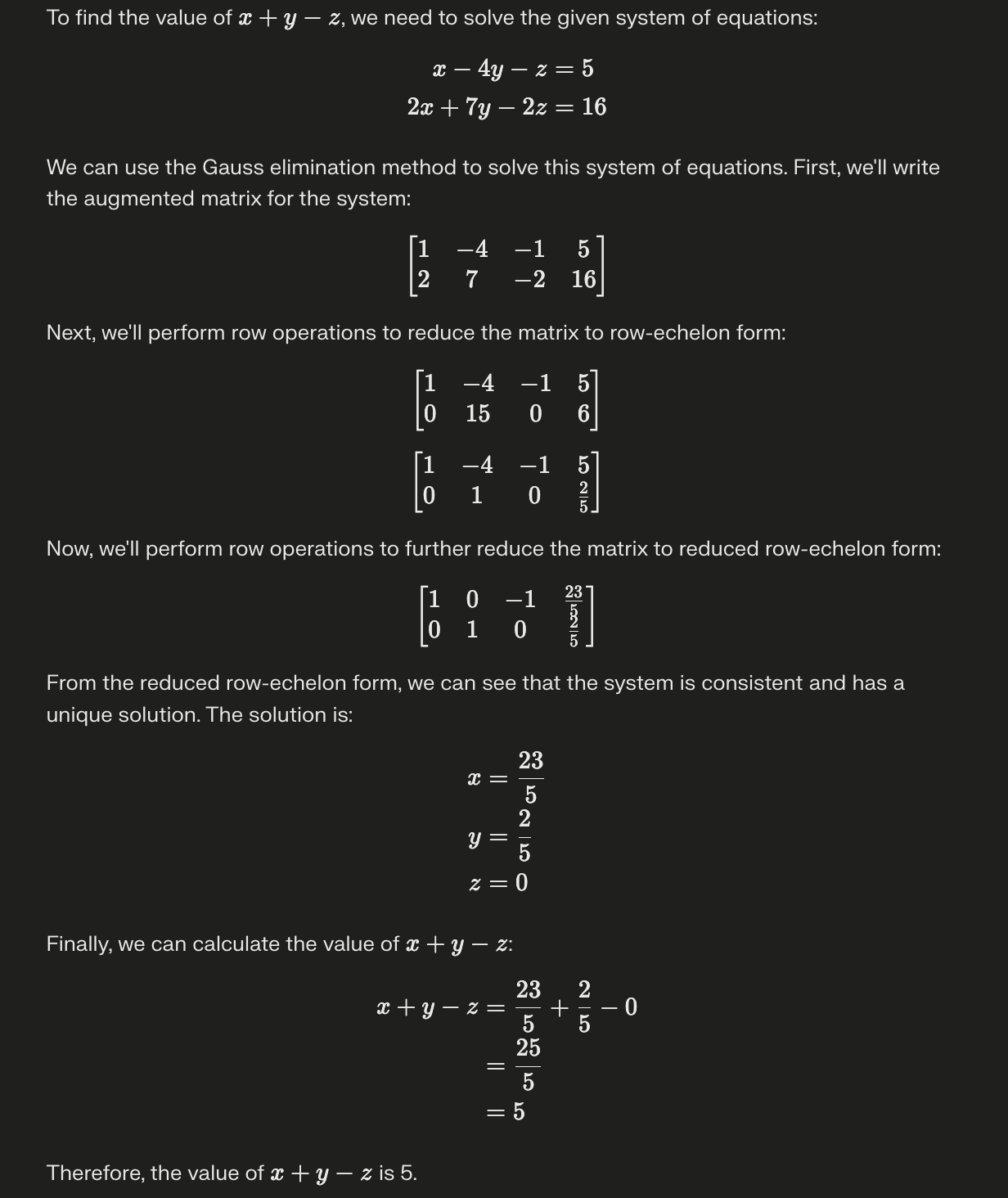
The answer is wrong. It went to many different lengths to find a solution.
Conclusion
We examined 5 of the most popular AI tools today, looked at their pros and cons, and compared the results by entering the same prompt into different tools.
The ideal chatbot options for different purposes such as education and business may vary. For example; for academic research, you can read summaries of different and up-to-date sources from Perplexity, you can take the source you like and examine it in Claude in a detailed but faster way, but it is better not to use these two tools for math operations. Otherwise, Bing or Bard can be useful for daily practical information. ChatGPT, on the other hand, can add another dimension to your outputs in different lanes with the features it offers in its Plus membership.
Just as there is no perfect human, there is no perfect AI tool for now. However, it is in our hands to make an AI tool perfect. If it is not a very detailed, exemplary, and long prompt, it would not be right to expect a perfect result from an AI tool by entering a single prompt. You may need to have a conversation with it, make it understand you, and guide it with examples.
This content was created by Ahmet Can Kavak, Marketing Manager at Zeo.
Sources
https://www.theverge.com/23610427/chatbots-chatgpt-new-bing-google-bard-conversational-ai
https://www.theverge.com/2023/3/24/23653377/ai-chatbots-comparison-bard-bing-chatgpt-gpt-4


















